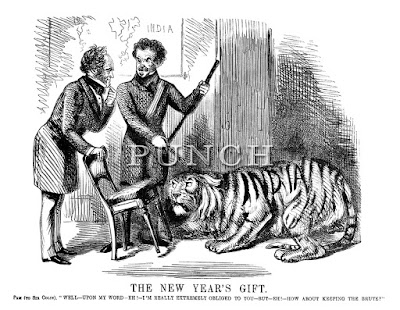 | |||||
George V'-howdah( left) dead tigers, Nepal. oldindianphotos.in
|
As George was very passionate about hunting wild animals, on the side lines of Delhi Durbar, a hunting trip had been arranged in Nepal at the invitation of Maharajah of Napal - Maharajah Chandra Shamsher Jang Bahadur Rana, Prime Minister and ruler of Nepal from 1901-1929. Previously George visited India as prince of Wales and a hunting trip in Nepal was scheduled. But, unfortunately it was canceled due to sudden outbreak of cholera in the region. Despite his tight engagements in India, King George V was looking forward to spending as much time as possible in big-game shooting in the wooded areas of Nepal.
The Tarai region of Nepal is a narrow strip of flat land, part of the Gangetic plains - the southern part is quite fertile, whereas the northern portion is marshy and rich in wild life. From 1846 to 1951 this area was used as a hunting ground by the rulers of Nepal. The wooded area is home to tigers. leopards, Gaurs (wild ox), occasional elephants and buffalo, and varieties of deer. The Lesser Rapti Valley, in the Chitawan district, is well known for Indian rhinoceros (Rhinoceros unicorns). Today Royal Chitwan National Park is a Natural World Heritage Site.
Th British king traveled up to a place called Bhikna Thori in India near the Nepali border by train. From the border he and his entourage traveled nearly 20 km by motor car. The hunting group mounted on the trained elephants and headed into the deeper part of the valley of the Rui River, King George was in the howdah and opened his account by shooting a tiger who tried to cross the stream. First day score was four tigers and three rhinoceros. Next five days the British royals and their counter parts in Nepal camped at Sukhibar, close to Rapti river. The entourage on 23 December moved farther and camped at Kasara. The Maharajah had a separate camp along the river and his party included 14,000 people including 2000 elephant attendants. At a special service called ''Divine Service'' on 24, December, 1911, the Maharajah presented the King with a collection of over seventy varieties of animals indigenous to Nepal, including bears.
Following day a special technique called 'ring 'was used for hunting with 600 elephants. The shikaries (hunters) employ an army of beaters for a few days prior to hunting to drive the animals to selected areas in the game reserve. They select numerous points for hunting. Using goats as a bait, they observe the movement of wild animals; if a wild animal - tiger or leopard is sighted it will be uniformly encircled by numerous elephants. They go for the kill only when every thing is ok.
The king had a field day on the last day 28 December 1911. The total score of animals yielded during the hunting trip in Nepal was quite mind-boggling, considering our present day laws related to conservation of endangered animals. The hunting parties bagged 39 tigers, 18 rhinoceros, and 4 bears. (Historical record of the Imperial visit to India, 1911, p.231-233).
https://anulib.anu.edu.au/using-the-library/collections/asia-pacific-digital-collections/his-imperial-majestys-shoot-in-nepalese-terai/
 |
| George V, Maharajah &, Nepali
soldiers and shikaries oldindianphotos.in |
 |
| image credit: SlidePlayer |
 |
| 18 rhinos killed. George V(right howdah), ruler of Nepal. oldindianphotos.in |
 |
| www.alamy.com |
The Tarai region of Nepal is a narrow strip of flat land, part of the Gangetic plains - the southern part is quite fertile, whereas the northern portion is marshy and rich in wild life. From 1846 to 1951 this area was used as a hunting ground by the rulers of Nepal. The wooded area is home to tigers. leopards, Gaurs (wild ox), occasional elephants and buffalo, and varieties of deer. The Lesser Rapti Valley, in the Chitawan district, is well known for Indian rhinoceros (Rhinoceros unicorns). Today Royal Chitwan National Park is a Natural World Heritage Site.
 |
| gift from Nepal ruler to King George V. 70 varieties,oldindianphotos.in |
 |
| head of a slain rhinos. 18 rhinos killed in this hunt..oldindianphotos.in |
 |
| image credit:Punch - PhotoShelter |
Following day a special technique called 'ring 'was used for hunting with 600 elephants. The shikaries (hunters) employ an army of beaters for a few days prior to hunting to drive the animals to selected areas in the game reserve. They select numerous points for hunting. Using goats as a bait, they observe the movement of wild animals; if a wild animal - tiger or leopard is sighted it will be uniformly encircled by numerous elephants. They go for the kill only when every thing is ok.
The king had a field day on the last day 28 December 1911. The total score of animals yielded during the hunting trip in Nepal was quite mind-boggling, considering our present day laws related to conservation of endangered animals. The hunting parties bagged 39 tigers, 18 rhinoceros, and 4 bears. (Historical record of the Imperial visit to India, 1911, p.231-233).
https://anulib.anu.edu.au/using-the-library/collections/asia-pacific-digital-collections/his-imperial-majestys-shoot-in-nepalese-terai/












